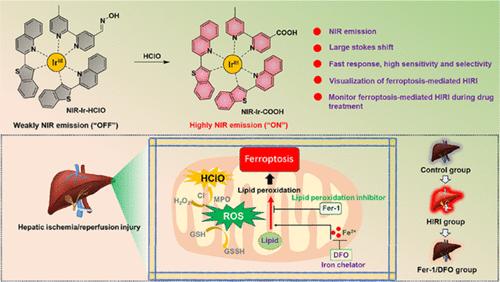基于线粒体靶向环金属化铱(III)络合物的发光探针,用于监测和评估铁蛋白沉积诱导的肝缺血再灌注损伤的治疗反应
IF 4.7
2区 化学
Q1 CHEMISTRY, INORGANIC & NUCLEAR
引用次数: 0
摘要
铁变态反应在肝缺血再灌注损伤(HIRI)的病理进展中起着至关重要的作用,而肝缺血再灌注损伤与铁依赖性脂质过氧化密切相关。由于线粒体被认为是活性氧(ROS)产生和铁储存的主要场所,因此监测线粒体次氯酸(HClO)(ROS 的重要成员)的变化对于评估铁变态反应状态以及制定 HIRI 的治疗策略具有重要意义。然而,目前仍缺乏可靠的成像工具来观察线粒体 HClO 并监测其在铁变态介导的 HIRI 中的动态变化。因此,本研究开发了一种 HClO 激活的近红外(NIR)环金属化铱(III)络合物探针,命名为 NIR-Ir-HClO,用于可视化监测铁突变介导的 HIRI 中线粒体 HClO 的通量。新制备的探针响应速度快(30 秒),灵敏度高,选择性好,细胞生物相容性好,线粒体靶向性能令人满意,适合用于活细胞线粒体 HClO 的精确监测。此外,该方法还首次实现了对铁突变介导的 HIRI 中线粒体 HClO 变化的可视化,以及对铁突变介导的 HIRI 对铁突变抑制剂治疗反应的监测。所有这些都表明,探针近红外-Ir-HClO可作为一种可靠的成像工具,用于揭示铁蛋白沉积介导的HIRI中线粒体HClO的病理机制,以及制定HIRI的新治疗策略。本文章由计算机程序翻译,如有差异,请以英文原文为准。

Mitochondria-Targetable Cyclometalated Iridium(III) Complex-Based Luminescence Probe for Monitoring and Assessing Treatment Response of Ferroptosis-Mediated Hepatic Ischemia-Reperfusion Injury
Ferroptosis plays an essential role in the pathological progression of hepatic ischemia-reperfusion injury (HIRI), which is closely related to iron-dependent lipid peroxidation. Since mitochondria are thought to be the major site of reactive oxygen species (ROS) production and iron storage, monitoring the variations of mitochondrial hypochlorous acid (HClO) (an important member of ROS) has important implications for the assessment of ferroptosis status, as well as the formulation of treatment strategies for HIRI. However, reliable imaging tools for the visualization of mitochondrial HClO and monitoring its dynamic changes in ferroptosis-mediated HIRI are still lacking. Herein, in this work, an HClO-activated near-infrared (NIR) cyclometalated iridium(III) complex-based probe, named NIR-Ir-HClO, was developed for the visual monitoring of the mitochondrial HClO fluxes in ferroptosis-mediated HIRI. The newly prepared probe showed fast response (<30 s), good sensitivity, excellent selectivity, good cell biocompatibility, and satisfactory mitochondrial-targeting performance, making it suitable for accurate monitoring of mitochondrial HClO in living cells. Moreover, visualization of the variations of mitochondrial HClO in ferroptosis-mediated HIRI and monitoring of the treatment response of ferroptosis-mediated HIRI to the ferroptosis inhibitors were achieved for the first time. All these show that probe NIR-Ir-HClO can be utilized as a reliable imaging tool for revealing the pathological mechanism of mitochondrial HClO in ferroptosis-mediated HIRI, as well as for the formulation of new treatment strategies for HIRI.
求助全文
通过发布文献求助,成功后即可免费获取论文全文。
去求助
来源期刊

Inorganic Chemistry
化学-无机化学与核化学
CiteScore
7.60
自引率
13.00%
发文量
1960
审稿时长
1.9 months
期刊介绍:
Inorganic Chemistry publishes fundamental studies in all phases of inorganic chemistry. Coverage includes experimental and theoretical reports on quantitative studies of structure and thermodynamics, kinetics, mechanisms of inorganic reactions, bioinorganic chemistry, and relevant aspects of organometallic chemistry, solid-state phenomena, and chemical bonding theory. Emphasis is placed on the synthesis, structure, thermodynamics, reactivity, spectroscopy, and bonding properties of significant new and known compounds.
 求助内容:
求助内容: 应助结果提醒方式:
应助结果提醒方式:


